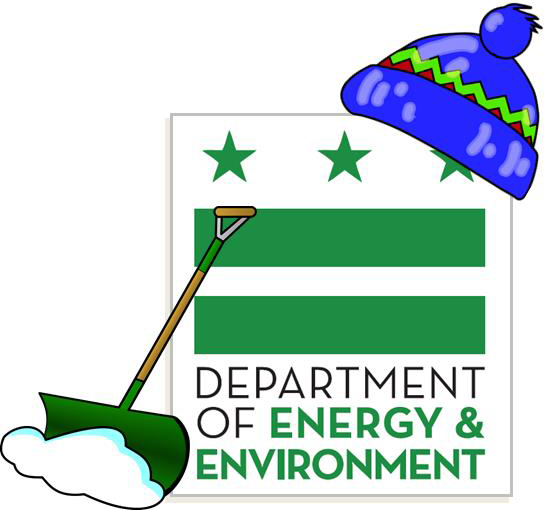
Winter weather brings its own set of environmental challenges to the District. As snow and ice accumulate it becomes contaminated with salt, litter, dirt, and other pollutants. During the spring thaw those pollutants are washed away and can clog stormdrains and contaminate District waterways, like Rock Creek and the Anacostia and Potomac Rivers. The emissions from idling car engines, gas-fueled equipment like snow blowers, and wood-burning fires can negatively impact air quality and harm human health.
Below is a list of things residents can do to help protect human health and the environment during the winter months. See what DOEE is doing.
- Remove snow before it turns into ice. Do your best to remove snow before it becomes compacted.
- Shovel snow onto lawns, planters, and other areas that are level or gently sloped so the snow melt can soak into the ground.
- Help your neighbor. Join DC Volunteer Snow Team to lend a helping hand to those who are not able to shovel. Signup online at SnowTeam.dc.gov or by calling 202-727-7925.
- Choose the right deicer. Some deicers, such as rock salt and calcium chloride, can be dangerous for children, pets, and the environment. Look for eco-friendly and pet-safe ice melt for a safer alternative.
- Use only enough to get the job done. The most common mistake with applying deicers is using too much. Read the directions on your deicer’s packaging for information on how much you need to apply. If you are using a mechanical applicator, make sure it is properly calibrated. Pick up any spilled product using a shovel or broom.
- Use traction instead. Applying small amounts of sand or sawdust helps keep people and vehicles safe on ice without adding chemicals to the environment. Remember to apply these sparingly and sweep up any that is left after the ice melts.
- Use battery, electric, or hybrid-powered snow blowers. This keeps our air clean, uses less fossil fuels, and helps prevent gasoline spills and leaks. For shorter stretches, such as walkways, shovel or sweep the ground clear with a broom instead.
- Minimize your emissions. Avoid idling your car for more than 3 minutes. Minimize how many wood-burning fires you make this winter or switch to a gas or electric fireplace.
- Ice-free designs. Porous asphalt and other permeable paving options help prevent ice because they are designed to absorb rain water and snow melt before it can pool and turn into ice. Learn how DOEE can help you install permeable surfaces through our RiverSmart program.
See what DOEE is doing to protect the environment during winter weather events.

